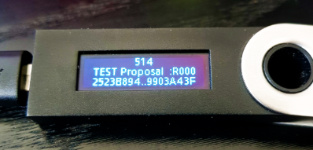Setting up Tendermint KMS + Ledger
::: danger Warning The following instructions are a brief walkthrough and not a comprehensive guideline. You should consider and research more about the security implications of activating an external KMS. :::
::: danger Warning KMS and Ledger Tendermint app are currently work in progress. Details may vary. Use with care under your own risk. :::
Tendermint Validator app (for Ledger devices)
You should be able to find the Tendermint app in Ledger Live.
Note: at the moment, you might need to enable developer mode in Ledger Live settings
KMS configuration
In this section, we will configure a KMS to use a Ledger device running the Tendermint Validator App.
Config file
You can find other configuration examples here
Create a
~/.tmkms/tmkms.tomlfile with the following content (use an adequatechain_id)# Example KMS configuration file
[[validator]]
addr = "tcp://localhost:26658" # or "unix:///path/to/socket"
chain_id = "desmos-mainnet-1"
reconnect = true # true is the default
secret_key = "~/.tmkms/secret_connection.key"
[[providers.ledgertm]]
chain_ids = ["desmos-mainnet-1"]Edit
addrto point to yourdesmosinstance.Adjust
chain-idto match your.desmos/config/config.tomlsettings.provider.ledgertmhas not additional parameters at the moment, however, it is important that you keep that header to enable the feature.
Plug your Ledger device and open the Tendermint validator app.
Generate secret key
Now you need to generate secret_key:
tmkms keygen ~/.tmkms/secret_connection.key
Retrieve validator key
The last step is to retrieve the validator key that you will use in desmos.
Start the KMS:
tmkms start -c ~/.tmkms/tmkms.toml
The output should look similar to:
07:28:24 [INFO] tmkms 0.3.0 starting up...
07:28:24 [INFO] [keyring:ledgertm:ledgertm] added validator key desmosvalconspub1zcjduepqepu8acj4qua576zzquvcly2un0xkzhwh0ehvgmx8gxgl34zhkceskthfp6
07:28:24 [INFO] KMS node ID: 1BC12314E2E1C29015B66017A397F170C6ECDE4A
The KMS may complain that it cannot connect to desmos. That is fine, we will fix it in the next section.
This output indicates the validator key linked to this particular device is: desmosvalconspub1zcjduepqepu8acj4qua576zzquvcly2un0xkzhwh0ehvgmx8gxgl34zhkceskthfp6
Take note of the validator pubkey that appears in your screen. We will use it in the next section.
Desmos configuration
You need to enable KMS access by editing .desmos/config/config.toml. In this file, modify priv_validator_laddr
to create a listening address/port or a unix socket in desmos.
For example:
...
# TCP or UNIX socket address for Tendermint to listen on for
# connections from an external PrivValidator process
priv_validator_laddr = "tcp://127.0.0.1:26658"
...
Let's assume that you have set up your validator account and called it kmsval. You can tell desmos the key that we've got in the previous section.
desmos gentx --name kmsval --pubkey {.ValidatorKey}
Now start desmos. You should see that the KMS connects and receives a signature request.
Once the ledger receives the first message, it will ask for confirmation that the values are adequate.

Click the right button, if the height and round are correct.
After that, you will see that the KMS will start forwarding all signature requests to the ledger:

::: danger Warning The word TEST in the second picture, second line appears because they were taken on a pre-release version.
Once the app as been released in Ledger's app store, this word should NOT appear. :::